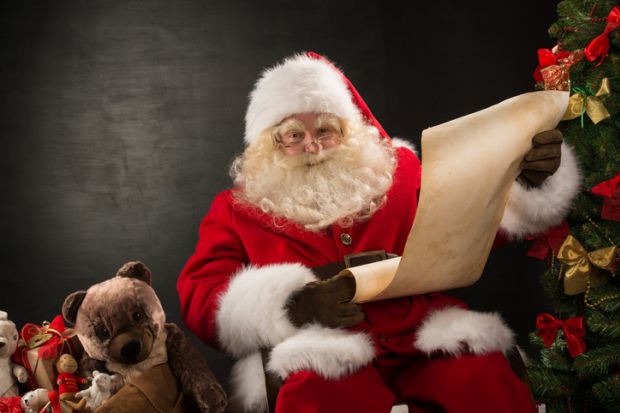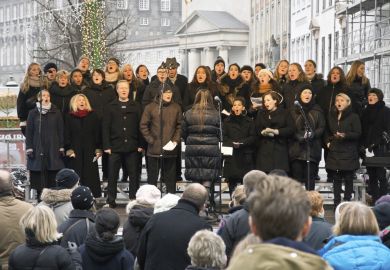How does Santa Claus fit all the presents into a single magical sleigh? And how does he know who has been naughty or nice?
These are just two of the problems that Father Christmas faces at this time of year, not to mention the perennial difficulties of keeping his elf workforce happy, and keeping his Lapland lair invisible and his flying reindeer in tip-top condition in the Arctic.
So it is good to know that old St Nicholas can call upon the support of the academic community, many of whom have applied their formidable brains to the challenges faced by Santa in the build-up to Christmas.
As part of the growing area of “Santa studies”, several journal papers have sought to identify some hazards that Kris Kringle might not have thought about.
For instance, researchers at the University of Basel (taking care to use only Santa Claus believers in their lab tests) used a paper in the journal Gait and Posture last year to warn Santa that carrying a sack weighing more than 20 kilogrammes could “tremendously” increase his fall risk.
“Spoiled kids and a tight schedule could make Santa fall,” they concluded.
The “unique occupational hazards” faced by Santa were also addressed in a 2015 paper by University of Alberta medics in the Journal of Occupational Medicine and Toxicology, saying health and safety issues had been almost entirely overlooked by previous Santa scholars.
Other medics have also wondered whether Santa’s rosy complexion may, in fact, indicate more serious medical problems, while disciplinary peers pondered whether his largely sedentary lifestyle may affect his jolliness. Finnish researchers have even asked, “Will climate change kill Santa Claus?”. Santa’s winter home, replete with snow, pine trees and reindeer, “is regarded as extremely susceptible to climate change”, says a paper published in the Scandinavian Journal of Hospitality and Tourism.
Meanwhile, an editorial titled “Santa Claus in the fertility clinic”, published in the journal Human Reproduction in 2016, will no doubt have raised plenty of issues that poor Santa may not have considered for a while – although its author, emeritus Maastricht University professor Hans Evers, was merely encouraging medical practitioners not to “play Santa Claus” by “doling out nicely wrapped presents of unnecessary, ineffective and costly care”.
Santa also has some pretty bad PR issues to address, according to recent academic literature.
His continued use of “Black Pete” as his blacked-up helper in the Netherlands (a well-known character in Dutch folklore) is growing increasingly controversial, explains a 2016 paper in Plos One, while a Journal of the Society for American Music paper on Santa as a “slave driver” in Civil War-era America teases out some controversial depictions of St Nick.
“Is it time to retire Santa?” asks a recent paper in The Journal of Post-Acute and Long-Term Care Medicine by St Louis medics, pointing out the dangerous example set by promoting a strong association between obesity and jolliness. He was also branded a “public health pariah” by Monash University academic Nathan Grills in 2009. “Santa is a late adopter of evidence based behaviour change and continues to sport a rotund sedentary image,” he points out.
Poor Father Christmas also has some deep existential worries, if you listen to researchers. One scholar – the University of Nottingham's Robert Cluley – even accuses him of being an excuse for “fetishism, ambivalence and narcissism” by parents.
“Parents, who know that Santa is not real, have been found to believe in Santa as if he were real. They both provide their children with misinformation about Santa and condition them into acting out their belief that Santa is a real person,” he writes in the journal Organization. “[This article] argues that parents’ role in this organization of Santa can be understood through the psychoanalytic concepts of fetishism, ambivalence and narcissism.”
Maybe Santa should just ignore the rather depressing scholarly advice on offer and turn to his trusted elves for advice on getting through his busy Christmas Eve.
Write for our blog platform
If you are interested in blogging for us, please email chris.parr@tesglobal.com
POSTSCRIPT:
Print headline: Santa: the peer-reviewed perspective
Register to continue
Why register?
- Registration is free and only takes a moment
- Once registered, you can read 3 articles a month
- Sign up for our newsletter
Subscribe
Or subscribe for unlimited access to:
- Unlimited access to news, views, insights & reviews
- Digital editions
- Digital access to THE’s university and college rankings analysis
Already registered or a current subscriber?






